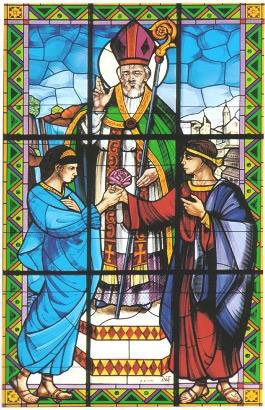The Beauty of Valentine’s Day
Valentine’s Day is widely recognized as a day of romance, gifts, and heartfelt expressions of love, but its origins are deeply rooted in Catholic tradition. Long before it became a commercialized holiday filled with roses and chocolates. Valentine’s Day was a feast day honoring St. Valentine. A priest who courageously upheld the sacredness of Christian marriage. Understanding the true history of Valentine’s Day from a Catholic perspective allows us to reclaim its deeper meaning. One of sacrificial love, faith, and the beauty of God’s plan for marriage and human connection.

Who Was St. Valentine?
The true identity of St. Valentine remains somewhat mysterious, as historical records mention multiple early Christian martyrs named Valentine. However, the most widely accepted story is that of St. Valentine of Rome. A priest who lived in the 3rd century during the reign of Emperor Claudius II.
During this time, the Roman Empire was engaged in numerous military conflicts. Emperor Claudius believed that unmarried men made better soldiers. As a result, he outlawed Christian marriages. Hoping that more men would enlist in the army without the distraction of family life. St. Valentine, recognizing the sacredness of Christian marriage, defied the emperor’s orders and continued to perform weddings in secret.
Eventually, Valentine was discovered, arrested, and imprisoned. While in captivity, he was said to have ministered to fellow prisoners and even healed the blind daughter of his jailer. Before his execution on February 14, 269 A.D., he allegedly wrote a farewell letter to the girl, signing it “Your Valentine“. A phrase that would later become synonymous with love and devotion.
The Catholic Meaning of Valentine’s Day
At its core, Valentine’s Day is not just about romantic gestures. It is about the kind of self-sacrificial love that St. Valentine exemplified. Love rooted in faith, courage, and commitment to God’s plan for marriage.
In Catholic teaching, love is more than just an emotional feeling; it is an act of will and self-giving, as described in 1 Corinthians 13:4-7:
“Love is patient, love is kind. It does not envy, it does not boast, it is not proud. It does not dishonor others, it is not self-seeking, it is not easily angered, it keeps no record of wrongs. Love does not delight in evil but rejoices with the truth. It always protects, always trusts, always hopes, always perseveres.”
St. Valentine’s unwavering commitment to Christian marriage and selfless love is a powerful reflection of God’s love for humanity. This is why the Catholic Church originally designated February 14 as the Feast of St. Valentine. A day to celebrate love in its truest and most faithful form.
How Valentine’s Day Evolved Over Time
By the Middle Ages, devotion to St. Valentine had spread throughout Europe. In the 14th and 15th centuries, poets like Geoffrey Chaucer began associating Valentine’s Day with romantic love. February 14 was believed to be the day birds began to pair off for mating season. This led to the tradition of sending love notes, which became known as “Valentines.”
By the 18th and 19th centuries, the practice of exchanging love letters and small tokens of affection became more common. Eventually, with industrialization, mass-produced Valentine’s Day cards and gifts became popular. Turning the feast day into the commercial holiday we recognize today.
Check out this post about Valentine’s Day Traditions Around the World.

Reclaiming the True Spirit of Valentine’s Day
For Catholics, Valentine’s Day is an opportunity to reflect on true love. The love Christ calls us to in our relationships, marriages, friendships, and faith. Here are some meaningful ways to celebrate the day with a Catholic perspective:
1. Pray for Your Loved Ones
Take time to pray for your spouse, family, friends, or even those who are struggling to find love. Ask St. Valentine to intercede for marriages, relationships, and all those discerning their vocations.
2. Celebrate the Sacrament of Marriage
For married couples, Valentine’s Day is a beautiful time to renew your commitment to each other, and reflect on the sacramental grace of your union. Consider attending Mass together, reading Scripture about love, or simply having a heartfelt conversation about your relationship.
3. Perform Acts of Charity
Love is not just about romance—it’s about self-giving. Take inspiration from St. Valentine and show love through acts of kindness. Such as helping a neighbor, calling a lonely friend, or supporting a charitable cause.
4. Write a Letter from the Heart
Instead of focusing on material gifts, take time to write a heartfelt letter to your spouse, children, or close friends, expressing gratitude and love. This small gesture can have a profound impact.
5. Reflect on God’s Love
Spend time in Eucharistic Adoration or personal prayer, meditating on God’s infinite love for you. Remember that the greatest love story of all is Christ’s sacrifice for humanity, as seen in John 3:16:
“For God so loved the world that He gave His only begotten Son, that whoever believes in Him shall not perish but have eternal life.”

A Final Thought: Love as a Reflection of Christ
Valentine’s Day is more than just a day for chocolates and flowers—it is an opportunity to rediscover the true meaning of love. St. Valentine’s unwavering faith and courage remind us that love requires sacrifice, commitment, and selflessness.
Whether you are celebrating with a spouse, family, or friends, may this day be a reminder of the beauty of love in all its forms—romantic love, friendship, and, most importantly, the divine love of God.
This February 14, let’s embrace the roots of Valentine’s Day by living out love in its purest and holiest form, just as St. Valentine did centuries ago. ❤️
How do you plan to celebrate Valentine’s Day in a meaningful way? Share in the comments below!
**This post may contain affiliate links, which means I make a small commission at no extra cost to you**